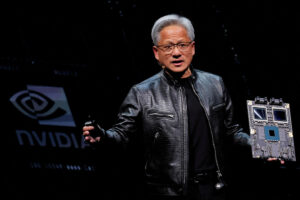Nvidia’s Stellar Journey: Dominating the AI Chip Market
In 2023, Nvidia (NVDA) transformed into a financial marvel, witnessing a surge in revenue and stock price that left many companies envious. This surge can be attributed to its strategic investments in artificial intelligence technologies, leveraging the generative AI wave that has captured the industry’s imagination and wallets alike.
A Leader Without Rival
Not only has Nvidia soared high in terms of revenue, but it has also consistently swapped places with Apple (AAPL) in the race for the largest publicly traded company in the world by market capitalization, recently breaking the illustrious $3 trillion mark. CEO Jensen Huang has become one of the most influential figures in Silicon Valley, engaging in dialogues with fellow tech leaders and global policy makers.
The Future Looks Bright
Nvidia is just getting started. The company is ramping up the production of its next-gen Blackwell chip targeted for AI applications, with an impressive forecast of shipping several billion dollars worth of its hardware in just the fourth quarter. What sets Nvidia apart is its ability to marry cutting-edge hardware with robust software ecosystems, making it a powerhouse in the AI landscape. As Daniel Newman from Futurum Group pointed out, Nvidia’s integrated approach captures both server rack technologies and developer-friendly software, a crucial advantage in fostering innovation.
Rising Competition
While Nvidia reigns supreme, it must also contend with a growing chorus of competitors. Companies like AMD (AMD) and even Nvidia’s customers themselves are channeling resources to develop chips aimed at reducing reliance on Nvidia’s products, which currently dominate an estimated 80% to 90% of the market share.
On Wall Street, optimism about AI-related investments is palpable. Broadcom (AVGO), which collaborates with tech giants like Google (GOOG, GOOGL) on AI chips, has seen its stock skyrocket 113% year-to-date, boosted by projections of a $60 billion to $90 billion opportunity by 2027 surrounding AI.
Market Dynamics: The AI Arms Race
Going forward, it’s clear that Nvidia’s position is not unassailable, even as it holds onto the lion’s share of the AI chip market. The company’s early investments in AI software allowed its graphics chips to function as high-performance processors, a first-mover advantage that remains a cornerstone of its business model. As Nvidia reported $35.1 billion in total revenue—87% derived from its data center business—cloud giants like Microsoft (MSFT), Google, Amazon (AMZN), and Meta (META) continue to invest heavily in securing Nvidia products for their infrastructure.
Bob O’Donnell from TECHnalysis Research highlights a compelling viewpoint, stating, “Everybody wants to build and train these huge models, and the most efficient way to do it is with CUDA software and Nvidia hardware.” This kind of industry validation underscores Nvidia’s near-monopolistic status and emphasizes why leading cloud providers are eager to stock up on its chips.
The Future of AI Processing
Looking ahead to 2025, Nvidia is expected to maintain its AI supremacy, especially with the release of the Blackwell chip, which has already sparked customers like Amazon to revamp data center cooling systems to handle the heat generated by high-performance processors. The current order backlogs are immense, with estimates suggesting that Nvidia may already be sold out for a significant portion of next year.
Despite rising competition from AMD’s MI300X and Intel’s Gaudi 3 processor, AMD appears better positioned to compete due to Intel’s leadership challenges. Still, gaining traction against Nvidia’s stronghold remains an uphill battle for others in the sector.
Not Limited to Chipmakers
Moreover, larger tech companies are taking matters into their own hands, developing proprietary AI chips. Google’s tensor processing units (TPUs), Amazon’s Trainium 2 processor, and Microsoft’s Maia 100 accelerator signify that Nvidia will face formidable homegrown alternatives.
As businesses pivot from training to "inferencing" AI models—significantly less resource-intensive than training—there’s concern that demand for Nvidia’s high-powered chips may decline. In response, Huang has emphasized that Nvidia’s chips are highly efficient in both training and inferencing processes, ensuring they remain relevant no matter which method dominates.
A Changing Landscape
Although Nvidia’s market share may experience fluctuations, the underlying growth of the AI space suggests it won’t crumble under competitive pressure. As Newman succinctly puts it, “This is definitely a case of raising all boats.” Even with more formidable competition emerging, Nvidia is not just surviving; it is thriving amidst the burgeoning demand for AI technologies, ensuring its growth trajectory remains solid.
As the landscape evolves, the competition will undoubtedly be fierce, but Nvidia’s strategic head start and technological advancements position it well to navigate the future of artificial intelligence. The challenge for competitors will be to innovate effectively and carve out their own slices of the AI pie in an industry where Nvidia has set the gold standard.
Stay tuned to Extreme Investor Network for ongoing insights and expert analysis as this high-stakes AI race unfolds!

